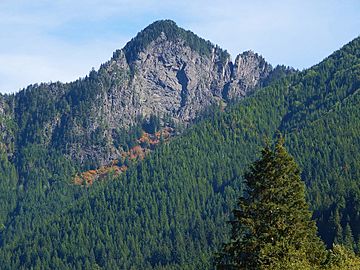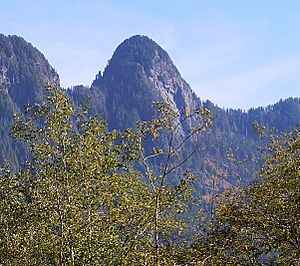Little Comrade (Washington) facts for kids
Quick facts for kids Little Comrade |
|
|---|---|

Little Comrade
|
|
| Highest point | |
| Elevation | 4,365 ft (1,330 m) |
| Prominence | 285 ft (87 m) |
| Geography | |
| Parent range | Cascade Range |
| Topo map | USGS Bandera |
| Climbing | |
| Easiest route | Scrambling |
Little Comrade is a small mountain peak found in King County, Washington state. It's part of the Cascade Range and is located within the Mount Baker-Snoqualmie National Forest.
Even though it's not super tall, Little Comrade stands out because it rises steeply from the land around it. The closest taller peak is Russian Butte, which is about 0.49 miles (0.79 km) away to the north-northeast. Rain and melted snow from Little Comrade flow into streams that eventually join the Snoqualmie River.
What's the Weather Like at Little Comrade?
Little Comrade is in a place with a 'marine west coast' climate. This means it gets a lot of influence from the nearby Pacific Ocean.
Most of the weather systems start over the Pacific Ocean. They then move northeast towards the Cascade Range. When these weather systems hit the tall Cascade Mountains, they are pushed upwards. This upward push makes them drop their moisture as rain or snow. This process is called Orographic lift.
Because of this, the west side of the Cascades gets a lot of rain and snow. This is especially true during the winter months. In winter, the weather is often cloudy. However, in summer, high-pressure systems over the Pacific Ocean usually bring clear skies.
The snow here tends to be wet and heavy due to the ocean's influence. This can lead to a high risk of avalanches.
How the Mountains Around Little Comrade Formed
The Cascade Range, where Little Comrade is located, started forming millions of years ago. This was during a time called the late Eocene Epoch.
Later, during the Pleistocene period (which began over two million years ago), huge sheets of ice called glaciers moved across the land. These glaciers repeatedly advanced and retreated. As they moved, they scraped and shaped the landscape. They left behind piles of rock and debris.
The last time glaciers retreated from this area was about 14,000 years ago. By 10,000 years ago, they had moved north of the Canada–US border. The river valleys in this region have a U-shape. This shape is a clear sign that glaciers carved them out.
The tall peaks and deep valleys of the Cascade Range were created by two main forces. These are uplift (when the land pushes upwards) and faulting (when cracks form in the Earth's crust). These forces, combined with the action of glaciers, shaped the mountains we see today.




